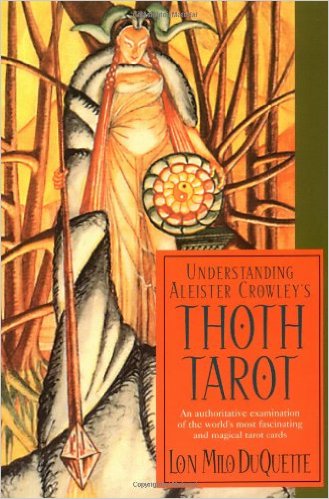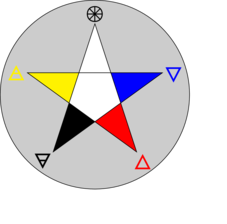Lon Milo DuQuette’s Understanding Aleister Crowley’s Thoth Tarot
 Understanding Aleister Crowley's Thoth Tarot
Understanding Aleister Crowley's Thoth Tarot
Weiser Books
2003
352

Lon Milo DuQuette has been a member of the O.T.O. since the 1970’s, and is a widely written and respected author in the magickal community. In Understanding Aleister Crowley’s Thoth Tarot (Weiser, 2003), he brings much-needed clarity to the understanding of the Thoth deck. His methods, though, are unusual, and the book does not progress as do other books on tarot.
The first 78 pages of the book discuss the history of Aleister Crowley, Lady Frieda Harris, The Book of the Law, and The Vision and The Voice. All of this is an attempt to explain both the differences between the Thoth Deck and other tarot decks, and also to provide a glimpse into the deeply spiritual and archetypal experiences that led to its creation.
Still within the 70 page section on background, we come to Chapter Eight: Secrets of the Rose Cross Back. This chapter is a clear and succinct introduction to the symbolism of the Hermetic Rose Cross and is recommended reading for anyone interested in this symbolism, regardless of their interest in tarot. As DuQuette states:
Properly understood, [the Rose Cross] is at once the door, the lock, and the key to the temple of the Western mysteries. It and the Tree of Life … quite literally are the Table of Contents of the tarot. (p. 39).
This introductory section ends with chapters on the Qabalah, color scales, and the Holy Guardian Angel (HGA), tying back to the symbolism used in Crowley’s Ordo Templi Orientis (O.T.O.) and how the HGA is connected with both the symbolism of the tarot and the sex magick of the O.T.O. (briefly and with sufficient obfuscation that no intelligible information can be derived from the explanation, other than the suggestion that these seemingly disparate ideas are somehow intimately connected).
If this book ended on page 78, it would be a highly valuable introduction and survey of the Western occult tradition and of how Crowley was a major influence on this tradition. The remainder of the book discusses each tarot card individually.
There are no surprises in the section on the Major Arcana. DuQuette makes a valiant, but thoroughly confusing, attempt to explain the switch that Crowley made between the Emperor and the Star. The explanation begins by quoting a letter from the Lady Frieda Harris (which are frequent historical additions provided throughout the text) and then provides some illustrations. First, is an illustration of a “Zodiacal belt”, which is just an elongated Zodiacal circle. Then we take the ordering of Leo, Virgo, and Libra, and “twist” the belt so that the new ordering is Libra, Virgo, Leo. This twist was introduced by the Golden Dawn so that Lust (Strength) could be associated with Leo and with Teth, and Adjustment (Justice) could be associated with Libra and Lamed. The twist is necessary because most of the trumps are associated in order with the Hebrew letters, also written in order. Before the Rider-Waite-Smith deck, Justice was 8 and Strength was 11, and other books that I have read will often return to the older ordering when discussing the psychology of the “Fool’s Journey”.
Crowley’s change to the Thoth deck was similar to the Golden Dawn change in that a “twist” was involved. But Crowley twisted the other side of the circle: the Aquarius, Pisces, Aries sequence became Aries, Pisces, Star. This resuls in the Emperor being associated with Aries and Tzaddi, and the Star with Aquarius and He. However, whereas the Golden Dawn changed the numbering of the cards, Crowley just changed the Hebrew letters, so I find his change much more confusing and the explanation here lacking.
After the Major Arcana, the next innovation not found in many other tarot books is to treat the Minor Arcana in an ordering that is related to the Tree of LIfe. So, DuQuette discusses all of the Aces in one section, and then moves on to treat all of the court cards in another section. In the introduction to these sections, he treats the Princesses as having a special relationship to the Aces; and then moves onto the Knights, Queens, and Princes.
Finally, we get to the small cards in the Minor Arcana, and DuQuette’s introduction is also novel in comparison to other tarot books. He provides linear mappings between the astrological signs and the cards (this looks better on a wheel, but DuQuette uses tables, so the reader can easily miss the cyclic nature of the mapping).
At the end of the book are a few pages on divination, and the reader comes to the realization that this isn’t a very good book for those interested in tarot divination. Indeed, the pages on each card describe the card and a great deal of symbolism in the painting, connecting with ideas from the first part of the book, and adding color to the history of the deck using quotes from letters between Harris and Crowley. But the suggested divinatory meanings are light and almost seem to be mentioned in passing, perhaps at the request of a publisher striving for a wider market appeal.
In conclusion, this book is delightful for the student trying to connect the symbolism of the Rose Cross, the Tree of Life, and astrology to the cards in the tarot deck and I recommend it as such. It is a “must read” for any serious student of the western tradition.
